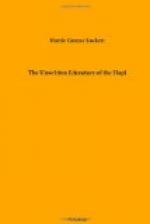If the adult spirit has led a good life, it goes to the abode where the ancestral spirits feast and hold ceremonies as on earth, but if evil it must be tried by fire and, if too bad for purification, it is destroyed.
XI. STORIES TOLD TODAY
* * * * *
Fewkes, Stephen, Mindeleff, Voth, and others have collected the more important tales of migrations and the major myths underlying both religion and social organization among the Hopi. One gets substantially the same versions today from the oldest story-tellers. These are the stories that never grow old; in the kiva and at the fireside they live on, for these are the vital things on which Hopi life is built.
However, there is a lighter side, of which we have heard less, to this unwritten literature of the Hopi people. These are the stories for entertainment, so dear to the hearts of young and old alike. Even these stories are old, some of them handed down for generations. And they range from the historical tale, the love story, and the tale of adventure to the bugaboo story and the fable. Space permits only a few stories here.
No writing of these can equal the art of the Hopi story-teller, for the story is told with animation and with the zest that may inspire the narrator who looks into the faces of eager listeners.
The Hopi story-teller more or less dramatizes his story, often breaking into song or a few dance steps or mimicking his characters in voice and facial expression. Sometimes the writer has been so intrigued with the performance she could scarcely wait for her interpreter (See Figure 13) to let her into the secret. Often the neighbors gathered round to hear the story, young and old alike, and they are good listeners. All of these stories save one, that of Don, of Oraibi, were told in the Hopi language, but having a Hopi friend as an interpreter has preserved, we think, the native flavor of the stories.
The first story, as told by Sackongsie, of Bacabi, is a legend concerning the adventure of the son of the chief of Huckovi, a prehistoric Hopi village whose ruins are pointed out on Third Mesa. The writer has since heard other variants of this story.
=An Ancient Feud,= as told by Sackongsie
“This is a story of the people that used to live on Wind Mountain. There is only a ruin there now, but there used to be a big village called Huckovi; that means wind on top of the mountain. These people finally left this country and went far away west. We have heard that they went to California, and the Mission Indians themselves claim they are from this place.
[Illustration: Figure 13.—The Author’s Interpreter at Walpi and Daughter, “Topsy.”]
“These people used to have ladder dances; that is an old kind of a dance that nobody has now. But we are told that a long time ago these people brought trees from far away and set them up in round holes made on purpose in the rock along the very edge of the mesa.




